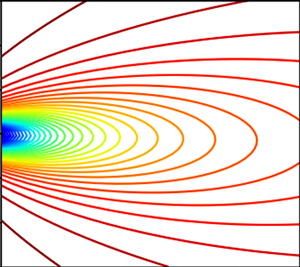Passive positioning and movement direction method based on Doppler shift change
DOI:
https://doi.org/10.3103/S0735272724100029Keywords:
OwlEars, radiolocation, acoustic location, Doppler shiftAbstract
The paper proposes a method for determining the location and direction of an object (hereinafter referred to as the OwlEars-1 method) based on changes in the Doppler shift of the signal emitted by this object. To determine the location, three short measurements are taken over one signal period to determine the relative change in the Doppler shift between these three measurements. There are several prerequisites for obtaining correct results. It is assumed that the object’s speed is known with a specific error, and the trajectory of movement is linear over the interval of three consecutive measurements. The absence or incomplete fulfillment of these prerequisites affects the method’s accuracy. The key advantages of the method are the use of the Doppler shift change as an input signal and the absence of the need for high-precision synchronization of receivers. The input data for the method is in the form of a change in the Doppler shift, instead of a signal without a Doppler shift, which allows the method to be applied to ambiguous signals. Low requirements for receiver synchronization simplify the implementation of the method, since only the change in the Doppler shift is used, unlike the phase method, where the TDoA (time difference of arrival) phase shift is the main parameter. The proposed mathematical model of the method has been validated by a series of simulations, particularly for a moving object emitting an acoustic signal. Further research steps are defined to investigate the method’s accuracy for various deviations from the assumptions made in the method.
References
- A. El-Rabbany, Introduction to GPS: The Global Positioning System. Boston: Artech House, 2002.
- T. A. Stansell, The Transit Navigation Satelite System: Status, Theory, Performance, Applications. Magnavox Government and Industrial Electronics Company, 1983.
- T. A. Stansel, “The many faces of Transit,” Navig. J. Inst. Navig., vol. 25, no. 1, pp. 55–70, 1978, uri: https://www.ion.org/publications/abstract.cfm?articleID=100670.
- B. Hofmann-Wellenhof, H. Lichtenegger, E. Wasle, GNSS — Global Navigation Satellite Systems. Vienna: Springer Vienna, 2008, doi: https://doi.org/10.1007/978-3-211-73017-1.
- D. V. Piaskovs’kyi, S. V. Kovbasiuk, V. I. Shestakov, “Determination of spacecraft motion parameters by Doppler gauges system,” Kosmìčna Nauk. ì Tehnol., vol. 7, no. 4, pp. 137–140, 2001, doi: https://doi.org/10.15407/knit2001.04.137.
- M. S. Grewal, A. P. Andrews, C. G. Bartone, Global Navigation Satellite Systems, Inertial Navigation, and Integration. New Jersey: Wiley, 2020, uri: https://www.wiley.com/en-us/Global+Navigation+Satellite+Systems%2C+Inertial+Navigation%2C+and+Integration%2C+4th+Edition-p-9781119547839.
- L. Yang, L. Yang, K. C. Ho, “Moving target localization in multistatic sonar by differential delays and Doppler shifts,” IEEE Signal Process. Lett., vol. 23, no. 9, pp. 1160–1164, 2016, doi: https://doi.org/10.1109/LSP.2016.2582043.
- R. T. Sharpe, P. G. Galyean, “An acoustic navigation system for site survey and geodetic positioning,” in Offshore Technology Conference, 1977, doi: https://doi.org/10.4043/2814-MS.
- D. Mares, E. Blackburn, “Evaluating the effectiveness of an acoustic gunshot location system in St. Louis, MO,” Policing, vol. 6, no. 1, pp. 26–42, 2012, doi: https://doi.org/10.1093/police/par056.
- Y. Chervoniak, R. Sinitsyn, F. Yanovsky, V. Makarenko, V. Tokarev, O. Zaporozhets, “Algorithm of passive acoustic locator data processing for flying vehicle detection and tracking,” in 2017 IEEE Microwaves, Radar and Remote Sensing Symposium (MRRS), 2017, pp. 43–48, doi: https://doi.org/10.1109/MRRS.2017.8075021.
- V. N. Oleynikov, V. M. Kartashov, S. A. Sheiko, O. V. Zubkov, E. I. Oleynikova, “Determining the location of small unmanned aerial vehicles by acoustic radiation,” Radiotekhnika, no. 210, pp. 113–127, 2022, doi: https://doi.org/10.30837/rt.2022.3.210.09.
- S. R. Martin, M. Genesca, J. Romeu, R. Arcos, “Passive acoustic method for aircraft states estimation based on the Doppler effect,” IEEE Trans. Aerosp. Electron. Syst., vol. 50, no. 2, pp. 1330–1346, 2014, doi: https://doi.org/10.1109/TAES.2013.120176.
- A. Sedunov, A. Sutin, H. Salloum, N. Sedunov, D. Masters, “Passive acoustic localization of small aircraft,” in Proceedings of Meetings on Acoustics, 201555005, doi: https://doi.org/10.1121/2.0000044.
- S. Y. Zhuk, T. V. Malenchyk, O. S. Neuimin, O. Y. Myronchuk, “Adaptive radar tracking algorithm for maneuverable UAV with probabilistic identification of data using coordinate and amplitude characteristics,” Radioelectron. Commun. Syst., vol. 65, no. 10, pp. 503–516, 2022, doi: https://doi.org/10.3103/S073527272212007X.
- Y. Chervoniak, R. Sinitsyn, F. Yanovsky, O. Zaporozhets, “TDoA and Doppler shift estimation method for passive acoustic location of flying vehicles,” in 2018 IEEE 17th International Conference on Mathematical Methods in Electromagnetic Theory (MMET), 2018, pp. 119–122, doi: https://doi.org/10.1109/MMET.2018.8460359.
- T. Yu, “An airborne passive positioning method based on angle and frequency difference measurement,” in Proceedings of the 2020 4th International Conference on Electronic Information Technology and Computer Engineering, 2020, pp. 296–301, doi: https://doi.org/10.1145/3443467.3443771.
- Y. Tao, “A Doppler location method based on virtual path difference,” J. Electron. Inf. Syst., vol. 5, no. 1, pp. 20–25, 2023, doi: https://doi.org/10.30564/jeis.v5i1.5496.
- Z. Yongsheng, H. Dexiu, Z. Yongjun, L. Zhixin, “Moving target localization for multistatic passive radar using delay, Doppler and Doppler rate measurements,” J. Syst. Eng. Electron., vol. 31, no. 5, pp. 939–949, 2020, doi: https://doi.org/10.23919/JSEE.2020.000071.
- T. Blanchard, J.-H. Thomas, K. Raoof, “Acoustic localization and tracking of a multi-rotor unmanned aerial vehicle using an array with few microphones,” J. Acoust. Soc. Am., vol. 148, no. 3, pp. 1456–1467, 2020, doi: https://doi.org/10.1121/10.0001930.
- B. Yang, E. T. Matson, A. H. Smith, J. E. Dietz, J. C. Gallagher, “UAV detection system with multiple acoustic nodes using machine learning models,” in 2019 Third IEEE International Conference on Robotic Computing (IRC), 2019, pp. 493–498, doi: https://doi.org/10.1109/IRC.2019.00103.


